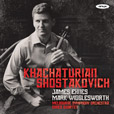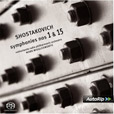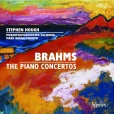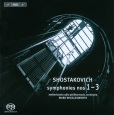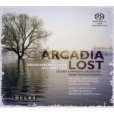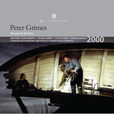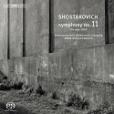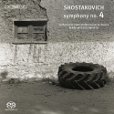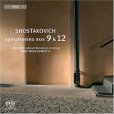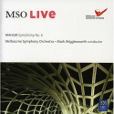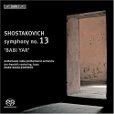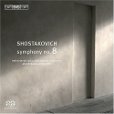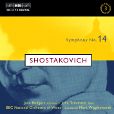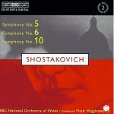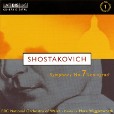Shostakovich Symphonies Nos. 1 & 15
The Netherlands Radio Philharmonic Orchestra
‘Wigglesworth’s Shostakovich cycle is the finest – and most consistently satisfying – in the catalogue.’ That was my response to the previous instalment in this series, which included the No. 1 reissued here. BIS have now covered all these symphonies, a project that began with the Leningrad in 1997. Even then – with the BBC National Orchestra of Wales – it was clear we were in for something rather special; that said, Wigglesworth’s more recent performances with the Netherlands Radio Philharmonic are in another league entirely. I’ve reviewed most of the latter, and their artistic strengths are matched by recordings of considerable range and splendour.
Over the years I’ve heard many accounts of these symphonies, all of different vintage and some of doubtful provenance. The one constant is the quality of the music itself; even the Cinderella pieces – Nos. 2, 3, 7 and 12 – respond gratefully to a thoughtful approach. Indeed, Wigglesworth’s quiet, cerebral progress is part of what makes his performances such a revelation. Happily that never seems to result in a lack of tension or drama; paradoxically, such a cool, analytical method allows the music to ‘speak’ plainly, without added histrionics or blatant manipulation. That’s no bad thing in scores that, for the most part, are already so volatile.
In that sense Wigglesworth’s Shostakovich is a palate cleanser, a necessary corrective to all that’s gone before. That’s not to say the insights of Kondrashin et al are any less valuable when it comes to understanding this complex, conflicted composer; if anything they all contribute to a multi-faceted, always fascinating portrait of a truly formidable talent. That prodigious gift is evident in the First Symphony, which some detractors suggest contains less of Shostakovich than first thought. Surely there’s too much of what we hear later – the mordant wit, the distinctive sonorities and those familiar progressions – for it to be anything other than an original, focused and very personal piece.
As I reviewed this version of No. 1 when it was coupled with Nos. 2 and 3 all I will say here is that revisiting it after a longish break has increased my admiration for both the work and Wigglesworth’s performance. No. 15, the culminating work in this most valuable cycle, was recorded at the same time as the First; collectors may well be irritated by the duplication, which could have been avoided with a new recording of, say, The Execution of Stepan Razin. I’d really like to hear more Shostakovich from this team, but I have a feeling that’s all we’re going to get.
Given what we’ve already received it seems churlish to complain. We must also be grateful for the number of fine Fifteenths in the catalogue. Haitink (Decca) has long been a favourite of mine, not least for his judicious blend of wit and introspection. Kondrashin’s Melodiya account is uniquely Russian – sometimes raw, always illuminating – as is Maxim Shostakovich’s recording of the 1972 premiere (on a Melodiya LP). Of more recent versions Dmitri Kitaienko (Capriccio) offers both a forensic examination of the score and top-notch engineering. That said, the one I turn to most is Kurt Sanderling’s with the Berliner Philharmoniker; first issued on the orchestra’s own label, this performance digs deeper and goes darker than any I know. Kondrashin’s 1974 Dresden account (Profil) isn’t far behind.
So, how does Wigglesworth’s Fifteenth fare in such august company? It takes a while to warm up – the first movement seems a little po-faced at the outset – but the mood does lighten thereafter. As always there’s nothing rushed about Wigglesworth’s reading, with every tic and nuance laid bare in the most natural and unaffected way. By contrast Haitink has more point and sparkle, and Decca’s sharpened edges add to the music’s brittle humour. Wigglesworth’s insistence on more air around the notes really pays dividends in the strange, disembodied second movement; the muted brass are unanimous, the twisting cello line is as wistful as any, and it’s all so thrillingly spectral.
The Allegretto is well shaped and sprung; the playing is wonderfully alert and precise, and the music’s quirks and quiddities are never overplayed. I wouldn’t have minded a bolder, more vivid sound – one has to crank up the volume for it all to snap into focus – but then this isn’t the mighty Eighth or Eleventh. Indeed, I’ve seldom heard this finale sound so quietly refined. Some listeners may prefer the upfront presentation of, say, Haitink, but Wigglesworth’s restraint and attention to detail are just as compelling. Moreover he builds climaxes from afar, so that when they arrive they do so with devastating impact.
It’s hard to believe that these performances are sourced from 44.1kHz originals, such is their presence and timbral accuracy; just sample the drum taps and soft tam-tam strokes in the finale, for instance. More important, there’s a sense of time suspended, of an audience holding its collective breath, and that’s very rare in a studio recording. At the heart of it all is Wigglesworth’s masterly control of structure and dynamics; the end result is discreet, direct and utterly absorbing.
Well worth the wait; a fitting end to this fine cycle.
Dan Morgan, MusicWeb-International, February 18th 2014
“The first release in Mark Wigglesworth’s Shostakovich cycle for BIS (of the Seventh Symphony) appeared as long ago as 1997. This pairing of the first and last symphonies completes the project, which has been shared between the Netherlands Radio Orchestra and the BBC National Orchestra of Wales. In fact, both these works were recorded eight years ago, and Wigglesworth’s performance of the First has been issued before, on a disc with the Second and Third Symphonies two years ago.
Reissuing it with the work at the very opposite end of the canon makes a good deal of sense, though. For there’s something about Wigglesworth’s approach to the First that seems determined to link it with the mainstream of Shostakovich’s symphonic writing, rather than treating it as a brittle example of his early flirtation with neoclassicism (which was followed by the modernist experimentalism of the Second and Third, and only after that by the evolution of a personal, genuinely symphonic style from the Fourth Symphony onwards). Wigglesworth shows that some of the qualities he finds in his delicate, almost balletic treatment of the first movement – and especially the weighty elements he unearths in its lento and finale – can be transferred directly across almost half a century to the 15th.
As Wigglesworth points out in his own thoughtful sleeve notes, that’s partly because Shostakovich set out in his final symphony to trace his own biographical journey in music, with a liberal use of allusions and direct quotations, not only from his own works but from a host of other composers, too – most obviously from Rossini’s William Tell in the first movement, and the fate motive from Wagner’s Ring and the opening of Tristan und Isolde in the finale. But hearing how the energy of the opening movement of the First translates into the more sardonic mechanics of the same movement in the 15th, and how the tragedy that the second movement of the 15th confronts what was already lurking in the 1920s, suggests that the real foundations of his symphonic thinking were laid right at the start of his composing career.
Now that it is complete, Wigglesworth’s cycle emerges as one of the finest of recent times, far more consistent and considered than its most obvious recent rival, from Vasily Petrenko on Naxos. The very wide dynamic range of the BIS recordings may be a problem to some listeners – turn up the volume to catch the detail of some of the extreme pianissimos and you risk being overwhelmed by the climaxes – but it’s well worth persevering.”
Andrew Clements, The Guardian; April 23rd 2014
“The playing is excellent. Wigglesworth’s clear-eyed examination of the score works particularly well at teasing out the eerie strangeness of some of the writing … The dynamic range and control of it makes the most of the climaxes … the end result is utterly absorbing and it comes coupled with Wigglesworth’s brilliant recording of Shostakovich’s first symphony … a fabulously immersive recording.”
Andrew McGregor, BBC Radio 3 Record Review Dis of the Week; May 17th 2014
‘Mark Wigglesworth has an excellent nose for this music. His cycle of the symphonies – split between Wales and the Netherlands – has thrown up some top contenders and even first choices, and this recoupling of the first and last of them conveys a satisfying sense of both the journey and its completion. Shostakovich’s beginnings in providing piano accompaniments for silent movies are much in evidence in the First Symphony. Wigglesworth’s BIS engineers have even given the piano a refreshing immediacy as the story board of the opening movement unfolds.
Everything from slapstick to melodrama is embraced and vividly chronicled in Wigglesworth’s performance. There are intimations, too, of Stravinsky’s Petrushka (that obligato piano again) and the Ballerina is much in evidence in the little flute melody that passes for a second subject. And to say that there is more than a touch of Tom and Jerry in the helter-skelter scherzo is to pretty much state the obvious. I love Wigglesworth’s characterful handling of the passage coming out of the Trio where a grumpy bassoon laboriously tries to get the movement up to speed again. The intrigue, the thematic sleight offhand, the dazzling accomplishment of this piece never fails to amaze (the composer was 18) – but this Wigglesworth performance, with cracking playing from the Netherlands Radio Philharmonic Orchestra, must be one of the best.
The slow movement turns the tomfoolery and melodrama on its head and glimpses the soul of a teenager who is already experiencing anger and disillusionment. Wigglesworth digs deep here and his attention to dynamics has us breathing a different kind of air at the heart of the movement. The intimations of mortality which haunt the Fifteenth and last symphony are much less than a lifetime away.
Just as Shostakovich said he felt as though he had been born again at the premiere of the First Symphony, so the opening of the Fifteenth takes us back to the nursery, to a second or even third childhood. The flippancy and childishness so well pointed by Wigglesworth (the silliness prompting that William Tell quote) is, of course, just the sort of irreverence the Soviets would have despised. Wigglesworth’s performance has a perverse logic to it and he’s so good at making a kind of sense of those passages that drift into the no-man’s-land of the composer’s imagination – like that strange meandering string fugue at the heart of the first movement.
The irony is, of course, writ large here; and, quite apart from the big rhetorical gestures that Wigglesworth’s orchestra and engineers deliver with such force, there is a quiet wryness in moments like the flippant redirection of the Tristan quotation away from the indeterminacy of Wagner’s famous chord. This piece knows exactly where it is going: towards the ticking percussion motif from his once outlawed Fourth Symphony. It’s a last laugh that is not lost on Wigglesworth.’
Edward Seckerson, The Gramophone; July 2014
‘It’s intriguing to experience Shostakovich’s first and final symphonies side by side. Superficially one might have expected there to be little tangible connection between works than span almost 50 years of a turbulent life. Yet for all its youthful exuberance, the grotesquerie in the opening movement and the scherzo of the First is surely recalled with even more sinister undertones in the equivalent movement of the later work. And although the slow movement and finale of the Fifteenth are on a much grander scale, the unexpected change of mood in the second half of the First Symphony already seems to hint at the tragic demeanour of the composer’s symphonic swansong.
These connections are brought vividly to life here. As in previous recordings in this fine Shostakovich cycle, Mark Wigglesworth provides compelling and insightful interpretations that keep you transfixed. Apart from the uniformly high quality of orchestral playing and the outstandingly brilliant SACD sound, the great strength of Wigglesworth’s interpretations lies in the keenly articulated response to every inflection, without ever sounding cerebral or lacking in emotional heft. Wigglesworth adopts expansive speeds for the outer movements of the Fifteenth, but he keeps a tight grip on the structure, building up climaxes of awesome power in the few passages where Shostakovich unleashes the full might of the orchestra. Likewise, the pacing is immaculate in the ominous funereal tread of the Adagio.’
Erik Levi, BBC Music Magazine; August 2014
It’s been a long time in the making – seventeen years, I believe, since the first release in 1997 – but at last Mark Wigglesworth’s Shostakovich symphony cycle is complete. I’ve come to the party quite lately – until relatively recently I’d only heard the Fourth and Eighth – but I did appraise the penultimate release in the series not long ago. That was a coupling of the first three symphonies and it seems a little odd to find the same performance of the First reappearing so soon, now in harness with the Fifteenth.
My colleague, Dan Morgan, has long been a standard bearer for the Wigglesworth recordings – indeed, it was largely his enthusiasm that persuaded me that I ought to investigate the series – and he’s already had his say about this final release in its download incarnation. It’s only about 18 months since I reviewed this performance of the First Symphony and my feelings about it haven’t changed; I still regard it as a very fine, searching performance. One difference since last time is that I’m now able to listen to the recording in SACD format and the BIS sound impresses me even more.
In the first movement Wigglesworth and his orchestra relish Shostakovich’s mordant wit; the playing is consistently precise and animated. In his notes the conductor points out the parallels with the sound world of Petrushka and in a performance such as this it’s not hard to envisage a puppet show. Wigglesworth mentions that as a teenager Shostakovich earned money playing the piano in silent movie theatres and, it is said, got the sack for laughing too much at Buster Keaton and Charlie Chaplin. That’s very believable when you listen to this music. In a super performance the solo clarinet, bassoon, trumpet and violin all make pithy, skilled contributions.
In the following movement the passages of fast music are very nimbly done while a shadowy character is imparted to the slower episodes. The third movement is the first in what was to be a long line of dramatic, eloquent slow movements in Shostakovich’s symphonic output. Wigglesworth leads a taut, probing performance which is characterised by towering climaxes and, even more so, by penetrating realisations of the many subdued passages; this is gripping stuff in his hands. Wigglesworth is excellent in the transition from the third movement to the fourth, bringing out the dark power in the music to perfection. This is a dark, anguished passage: can it really be the invention of an eighteen-year-old? A similar thought is prompted by the plaintive cello solo after the rhetorical timpani solo. The allegro sections are driven along frantically, the energy levels high. This is a tremendously strong performance of the movement and, indeed, of the whole symphony. Our appreciation is heightened further by the recording which is stunning in its immediacy; as an example, listen to the pivotal timpani solo in the finale (track 4, 6:00), though the way in which, elsewhere, hushed detail is captured by the engineers is just as impressive.
In some ways I regret that it wasn’t possible to provide a new coupling to accompany the recording of the Fifteenth Symphony but, even if the recording of the First Symphony appeared less than two years ago there’s a compelling logic for reviving it here. The pairing of the composer’s first and last symphonies has a great deal to commend it. When I first reviewed Wigglesworth’s account of the First I wrote that I was struck by a comment he makes about the influence of Petrushka and, indirectly, perhaps of Pierrot Lunaire on that score: ‘the disconcerting idea of human beings as puppets, with their actions manipulated by unseen string-pullers from on high, was one that stayed with the composer right the way through to his final symphony, written almost fifty years later.’ Now, as he turns to the Fifteenth, Mark Wigglesworth underlines the links between the two works not only in his performances but also in what he says about the music. He reminds us that Shostakovich is reported to have said of the first movement that the music ‘describes childhood, a toy-shop with a cloudless sky above’. Wigglesworth then extends the metaphor by quoting an earlier, grim remark of the composer’s: ‘We are all marionettes’. More controversially, perhaps, he suggests that ‘Perhaps it was not unconnected in Shostakovich’s mind that the USSR’s largest toy store stood just across the street from the Lubyanka, the infamous KGB torture headquarters.’ Is that stretching the argument too far? I’ll leave that to you to decide but I find it an interesting and, indeed, provocative idea.
I started off my listening to the Fifteenth with the intention of making comparisons. I noted, for instance, that in the first movement Wigglesworth paces the music intelligently. Kurt Sanderling, in his 1978 recording (Berlin Classics) achieves a similar intensity at a comparable pace whereas Kirill Kondrashin, in his 1974 reading, is much swifter – dangerously so, I think, risking the appearance of skittishness. I had also intended to bring into the comparison the more recent recordings by Bernard Haitink and Vasily Petrenko, both of which I compared not long ago. However, as I continued to listen to Wigglesworth my desire to compare this point or that faded; I just wanted to absorb his performance on its own merits.
I disagree very mildly with Dan Morgan, who thought that the first movement takes a while to warm up. The interpretation seems quite dark to me right from the start; notice that, for instance, not so much in the bassoon solo at 0:47 as in the way Wigglesworth gets the string players to voice the little figurations that surround that solo. Superficially, a good deal of the music in this movement may appear perky but in this performance there’s no real perkiness. The playing is acutely pointed and you feel that even if you’re not listening to a dance of death you’re certainly hearing a very grim dance. As was the case with the companion symphony, the recorded sound is superb – listen to the thwacks on the bass drum at 4:20. The sardonic nature of the music is tellingly realised by Wigglesworth and his orchestra; this, it seems to me, is the apotheosis – if that’s not a contradiction in terms – of Shostakovich’s bitter, wry humour and the juxtaposition of the two symphonies on the same disc becomes ever more valuable: it’s as if the Till Eulenspiegel-like composer who penned the First is now seen again after over four decades of difficult times.
In the second movement the gaunt solo cello passages, with glacial string accompaniment, make a tremendous impression: this is music pared down to the barest essentials. The sombre brass chorales that punctuate the cello passages are ominous and intense. Further into the movement the pair of flutes that join the cello at 5:39 have a ghostly pallor to their sound while the trombone at 6:39 is as baleful as you could wish. I mention these instances because it must require hours of intense rehearsal and a deep understanding of how the music should sound in order to attain this level of accomplishment in delivering it. Throughout the movement the control in playing the soft stretches of music is quite superb. At 9:28 the massive climax confronts us and because it has erupted after so much soft playing and spare textures it’s all the more imposing; it’s like having a sudden vision of a massive, implacable glacier. This is a magnificent, draining account of the movement.
Wigglesworth compares the start of the third movement to the carping of the Hero’s Critics in Ein Heldenleben. I’d never thought of it that way but this thought is now likely to be, I suspect, one of those ideas that once planted in the brain will never be forgotten: it seems spot-on to me. Equally memorable is the conductor’s description of this scherzo as ‘Alice in Wonderland as told by the brothers Grimm.’ The playing throughout this movement is pungent and incisive.
The Wagner quotations at the start of the finale are pregnant with tension. In the pages that follow Wigglesworth and the orchestra demonstrate the utmost concentration and focus. There’s a passacaglia in this movement and I like his description of the passacaglia form as ‘a dance that does not go anywhere, an unchanging bass line that imprisons the melodies above it.’ That description of the bass line so typifies Shostakovich’s use of the passacaglia – think of the fourth movement of the Eighth Symphony. The build-up to the movement’s climax is a tense affair and then the moment itself is upon us (9:17-10:24). This was to be Shostakovich’s last-ever climax in a symphonic movement and it’s a mighty example, full of dread power. Thereafter in the long after-climax the movement winds down gradually, almost as if the composer is emotionally and physically spent. I don’t think I’ve ever heard the series of weird discords from various combinations of instruments sound quite like they do in this performance (from 14:34) and then the symphony peters out with the enigmatic, quiet percussion figures: what does it all mean? I’m still far from sure but I do know that I’ve learned a lot more about this work and feel I understand it better as a result of reading Mark Wigglesworth’s thoughts on it and, especially, from hearing him conduct it.
I said earlier that I’d abandoned comparisons in favour of listening to Wigglesworth’s performance which is, quite simply, the finest rendition of this strange, enigmatic symphonic envoi that I can remember hearing. It’s a very fine conclusion to Mark Wigglesworth’s Shostakovich cycle. Anyone who has been collecting the cycle as it has evolved is unlikely to need any prompting from me to acquire this disc. And if you have Wigglesworth’s disc of the first three symphonies, don’t be put off by the duplication of the First Symphony; it’s worth it to experience such perceptive, enthralling conducting of the Russian composer’s first and last symphonies: an ideal coupling in every respect.
John Quinn, MusicWeb International, May 2014
‘This release completes Mark Wigglesworth’s generally excellent Shostakovich cycle. It’s a pity that another coupling for the Fifteenth Symphony could not have been found, since the First already has appeared alongside the Second and Third. On the other hand, no one especially cares about the Second and Third, so having Shostakovich’s first symphonic essay hitched to his last isn’t a bad idea, even if collectors acquiring this cycle one disc at a time may be annoyed. Presumably when the inevitable boxed set gets released, this will all be sorted out.
As mentioned in my review of the First Symphony, it’s a performance that gets better as it goes. The first movement, crisp and clear though it undoubtedly is, lacks that element of exaggerated humor that it ideally needs—it’s a function perhaps of less than characterful woodwind solos combined with a slightly low-level recording. The scherzo, swift and pointed, also could do with more devilry, but the Lento movement and finale remain impressive on re-hearing.
The Fifteenth Symphony features an interesting interpretation, deliberate and deadly serious even in the lighter moments, rather like Sanderling’s for those of you who know it. Its opening movement is on the slow side, but still clearly Allegretto. The big climaxes in the Adagio and the Finale are tremendous: grinding and terrifying, and powerfully sustained, while the Scherzo sounds as hollow and spooky as any on disc. As with the First Symphony, the dynamic range on this SACD is almost too wide: the soft bits are exceptionally quiet, while the climaxes risk antagonizing your neighbors. Nevertheless, the performance makes an imposing conclusion to a cycle that, quietly and without much fanfare, ranks among the best.’
David Hurwitz,
ClassicsToday.com; June 2014
‘This SACD disc has the Symphony No. 1 and Symphony No. 15 marking both ends of Shostakovich’s symphonic output. This disc also makes the completion of this series of discs from BIS and composer Mark Wigglesworth. It has been a long process, the first recording was the Seventh Symphony in 1997.
Shostakovich wrote the Symphony No. 1 completing it when he was 19. It was written as a graduation piece at the Petrograd Conservatory in 1925. Some of the themes reflect music the composer wrote when he was much younger, and the symphony, filled with exuberant joy as well as deep reflection is still popular today.
The performance by the Netherlands Philharmonic is excellent and played with precision. The recording is really a fine one, with very strong instrumental definition and positioning. I listened in the native 5.0 surround, and most of the sound is up front where it belongs, with a hint of hall ambience in the rear.
The Symphony No. 15, written almost 15 years later, in 1971, during a one-month burst of energy. It was first performed in Moscow in 1972.
The symphony is remembered today for many dramatic moments, including a rather eerie coda centering around a sustained pedal point with a dramatic and exciting percussion toccata featuring castanets, snare drum, wood block, xylophone, and triangle. The symphony quotes from the Shostakovich 4th and 7th Symphonies, which the composer often did, and the 15th is full of these quotes, including references to the William Tell Overture and the music of Glinka and Mahler.
Here again, Wigglesworth gets an aggressive and fine performance from the orchestra, especially the percussionists who are spotlighted in the work. The recorded sound is first rate, and while the recording itself is not new, dating from 2006. it is faultless.
BIS has what I consider to be the finest recorded series of the Shostakovich symphonies so far. Not all the editions are SACDs as this one, but the full set is as much as any aficionado of the composer could hope for in performance and recording quality. BIS should offer the cycle in a set so people don’t have to buy them separately.’
Mel Martin, Audiophile Audition; July 12th 2014
‘Mark Wigglesworth is one of the best Shostakovich conductors out there; I’d go so far as to say one of the finest conductors of our times. In contrast to so many others, he pays painstaking attention to details of phrasing. There’s no coasting in any of his recordings, no sketchiness on the way that lies between points of greater tension and apparent importance. He really captures every single twist of musical mockery in the first movement of his First; the double-time waltz has never had its colors so clearly delineated, in my experience, or to such sickeningly sweet effect. But momentum lags; and the scherzo that follows never takes off. The outer sections are far too serious, too restrained—none of the parody here of silent film chase scenes that Shostakovich, who was a theater pianist accompanying those films, meant for this section—while the central trio becomes so expressive in its pursuit of color that it expands to cover everything. Not surprisingly, the most conservative and conventionally symphonic movement in the work, its third, finds Wigglesworth entirely on the mark. He catches the cyclical aspect of the fourth movement as well, but misses the obvious efforts by the composer to derail a typically Russian celebratory finale.
Wigglesworth’s 15th again shows his mastery of phrasing detail, but it’s his ability to build a movement that comes to the fore here. It’s especially appreciated in a work that lacks a clear outline and has been accused of being episodic. Under Wigglesworth’s direction each movement has a clear frame with structural elements that integrate clearly, in such a fashion as to seem the only appropriate way as long as that movement lasts. The first is deceptively gentle, though here and later the conductor finds an ice-cold edge to the brass band chorales that dot the symphony. The concentrated power of Maxim Shostakovich/Moscow RSO (out of print) is missing, but the second movement paints a dark, bleak canvas in which the lamenting string solos are quickly smothered by the tonal clusters. The scherzo is a bit closer to the unbuttoned Wigglesworth I’ve heard in live concert, and has some of that nose-thumbing which was completely lacking from the First. The finale is once again gentle, but the unstable tonality, swift-moving accompaniments, and generally reduced dynamics create an impression of smooth waters looking down into darkness. Of course, the conductor points the return of the tonal clusters from the second movement, and gets just the right amount of frost into the toy store’s eerie reappearance as well.’
Barry Brenesal; Fanfare October 2014
